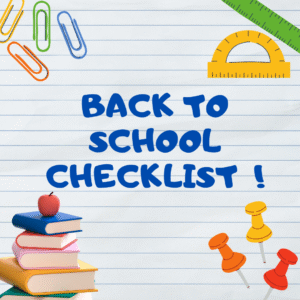
Read Time: 5 Min
Preparing for back-to-school season can be a busy and emotional time for families with children who have disabilities. Here’s a comprehensive checklist to help special needs parents stay organized and ensure a smooth transition to the school year:
- Review IEP/504 Plan
-
- Schedule a meeting with the school to review or update the Individualized Education Plan (IEP) or 504 Plan.
-
- Ensure accommodations, modifications, and support services are updated based on your child’s current needs.
-
- Discuss any changes in behavior, medical conditions, or therapy requirements.
-
- Confirm any assistive technology needs or tools for learning.
- Coordinate with Therapists and Service Providers
-
- Contact speech, occupational, physical, or behavioral therapists to confirm upcoming sessions or changes in treatment plans.
-
- Share any updates from your child’s IEP or other educational documents with therapists for alignment.
-
- Set up or confirm transportation arrangements if therapy sessions are off-site.
- Organize Medical and Emergency Information
-
- Ensure the school has up-to-date medical records, including any new diagnoses, medications, and treatment plans.
-
- Provide the school with emergency contact information and specific instructions regarding your child’s medical needs.
-
- Review and update an emergency care plan for things like seizures, allergies, or other conditions.
- Prepare School Supplies and Learning Tools
-
- Review the school supply list and customize it with any additional tools your child may need, such as sensory items, noise-canceling headphones, or fidget toys.
-
- Ensure your child has the necessary school materials, such as adaptive tools, notebooks, or any special equipment.
-
- Consider organizing a system to help your child manage their materials, like labeled bins or color-coded folders.
- Check Transportation Arrangements
-
- Confirm transportation details with the school or any special needs transportation service, including pick-up and drop-off times.
-
- Ensure that the vehicle or bus is equipped to meet any of your child’s specific needs (e.g., seating, wheelchair access).
-
- If your child has specific sensory needs during transportation, communicate those to the school.
- Prepare Your Child Emotionally
-
- Discuss the upcoming school year with your child, addressing any anxieties or questions they may have.
-
- Practice routines that will help with transitions, such as waking up earlier, getting dressed, and packing a backpack.
-
- If your child has difficulty with social interactions, practice social scripts or role-playing scenarios.
- Meet with the School Staff
-
- Schedule a meeting with the principal, teacher, and special education team to discuss any necessary support services.
-
- Provide important background information about your child, including learning styles, triggers, and strategies that work.
-
- Ask about school policies on bullying, behavior management, and how they handle emergencies related to your child’s disability.
- Review Financial Assistance and Benefits
-
- Check if there are any available financial assistance programs for school supplies, uniforms, or special services.
-
- Review your child’s eligibility for government programs or tax breaks that may help with school-related costs.
-
- Confirm any changes in insurance coverage for therapies or medical needs during the school year.
- Create a Routine for the School Year
-
- Establish a consistent daily routine, including wake-up time, meals, homework time, and bedtime.
-
- Consider your child’s sensory needs and make adjustments to the environment, such as calming techniques or sensory breaks.
-
- Plan for weekly or monthly check-ins with teachers and other staff to ensure everything is going smoothly.
- Plan for Extracurricular Activities and Social Events
-
- Review any after-school programs or social activities that your child may participate in and ensure they’re accessible.
-
- If your child struggles with socializing, consider setting up playdates or smaller group activities to build social skills.
-
- Ensure that any extracurricular programs are equipped to meet your child’s needs, such as providing a quiet space or specialized care.
- Check for Available Community Resources
-
- Research local resources or support groups for families with children with disabilities.
-
- Look into any new community programs, services, or events that may benefit your child this school year. Check out Clover Leaf’s Guide for Community Resources
-
- Keep a list of helpful contacts, including educational advocates or specialists who can assist if any issues arise.
- Maintain Communication with School Staff
-
- Set up a communication plan with teachers, aides, and support staff to ensure regular updates on your child’s progress.
-
- Keep lines of communication open, especially if any changes or challenges arise during the year.
-
- Provide feedback on what strategies are working and what adjustments may be necessary.
- Focus on Self-Care
-
- Make sure you’re taking care of yourself as well. Parenting a child with disabilities can be overwhelming, so don’t forget to carve out time for rest and self-care.
-
- Reach out for support if you need it, whether from friends, family, or professional resources.
-
- Maintain a balance between supporting your child’s needs and finding time for your own well-being.
By following this checklist, special needs parents can stay organized and ensure their children have the tools, support, and care they need for a successful school year.

Recent Comments